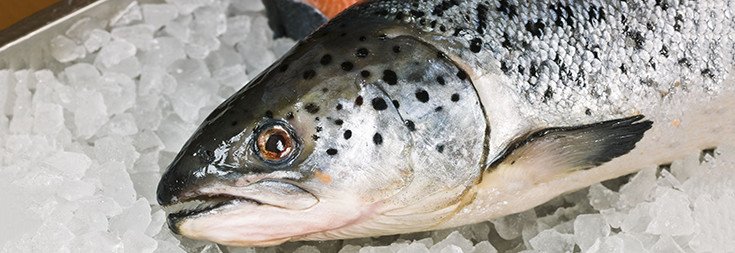How Will You Know if Your Store is Selling GM Salmon?

AquaBounty was very covert in its development of genetically modified salmon, eliciting a lawsuit against the Canadian government for producing GM salmon eggs, imported from facilities in Panama. Now that the FDA has deemed GM salmon ‘safe for sale,’ how will you know if your store is going to carry it, since the FDA does not require labeling? AquaBounty’s answer is vague.
“It is too early to discuss commercialization plans, but there are several paths to market that are being considered,” AquaBounty spokesperson Dave Conley told Civil Eats. [1]
Your grocery store, farmers or fish market won’t have to tell you whether or not you are purchasing GM fish. According to the “voluntary guidelines for GMO labeling” the FDA proposed when it approved the salmon last week, that decision will be left entirely up to the companies selling the fish.
Stores like Costco have vowed that ‘for now’ they aren’t planning on selling the GM fish, but as Food & Water Watch assistant director Patty Lovera says, the odds that companies will disclose this information are incredibly low. In fact, she has yet to see a food company do so. “The practical effect of voluntary labeling is no labeling.”
There are a few ways to minimize the possibility of eating GM fish, though. Aside from demanding that your grocery store disclose whether or not it is selling the genetically modified variety, the country-of-origin (COOL) label required by the U.S. Department of Agriculture (USDA) has to say where the salmon comes from. Many retailers also label if salmon is farm-raised or wild caught.
Though the GM salmon (supposedly grown in captivity), have already shown that they could easily contaminate other fish populations, even brown trout, if you purchase wild caught fish that is NOT grown in Panama, the chances that you’ll be eating GM fish should significantly decrease.
Furthermore, if the salmon has been processed and added to other ingredients, like salmon spread or a salmon burger, it is more likely to have been grown with GM salmon.
As of today, according to Center for Food Safety analyst, Jaydee Hanson, the only commercially-grown salmon in Panama is genetically modified.
AquaBounty maintains that its GE salmon will be “traceable.”
Sources:
[1] KQED

Where is GMO Dan or whatever his name is. Maybe he got a life.
GMO Rob I think. Oh .. he’ll be here. I often wonder if entities like him aren’t just one identity who is actually made of several people – say, ten Monsanto employees. They all take turns, around the clock, so that every GMO article everywhere, entities like “him” (and the others) can respond all the time. Surely no one has the spare time to do this all day long, making comments everywhere, without some kind of situation to support it.
Salmon was already one of the worst foods you can eat so being GMO don’t make a lot of difference
Your grocery store, farmers or fish market won’t have to tell you whether or not you are purchasing GM fish. According to the “voluntary guidelines for GMO labeling” the FDA proposed when it approved the salmon last week, that decision will be left entirely up to the companies selling the fish.
That’s how a free society works. Sellers offer what they have for sale, revealing anything they please about it. Potential buyers decide whether the information offered is sufficient, and whether the price is acceptable, and they either buy or walk away.
But Ms. Sarich flaunts the fact that she hates freedom. She wants the cold, dead hand of government setting the rules for every transaction. Voluntary terms negotiated between buyer and seller are totally passé, in Sarich’s mind.
God spare us from people who want to run our lives for our own good!
I have tried GMO salmon, farm raised non-GMO salmon, and I eaten regular fresh caught salmon.
In comparison I think the GMO salmon tastes the best, and has the best texture.
So, for my money, I will prefer the GMO salmon to buy.
You won’t know which is which as it’s not labeled LOL.